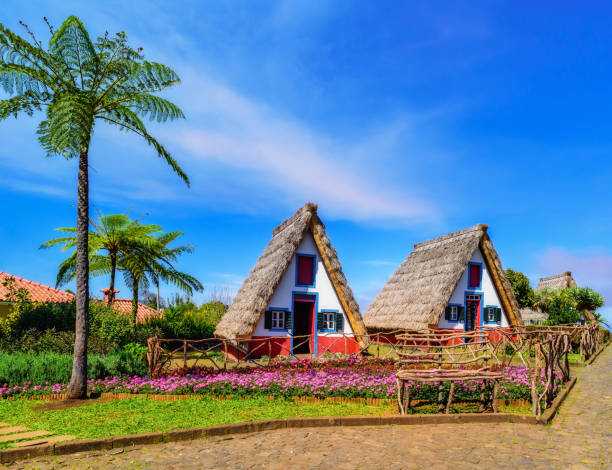Santana
Santana is a picturesque village located on the northern coast of Madeira Island, Portugal. It is one of the most popular destinations on the island due to its traditional charm and typical thatched houses called 'palheiros'. Here is some information about Santana:

1. Thatched Houses: Santana is famous for its traditional thatched houses. These small colorful houses have conical thatched roofs, giving them a unique appearance. They are considered a symbol of Madeira's traditional architecture.
2. Santana Theme Park: Free entry to learn more about the culture and history of Santana; you can visit the Santana Theme Park. This park offers interactive exhibitions about the history, nature, and traditions of the region.
3. Santana Hikes: The surroundings of Santana offer many hiking opportunities. You can explore trails that will take you through beautiful natural landscapes, such as levadas (irrigation channels) and the surrounding mountains. Levada Do Caldeirao Verde.
4. Santana Market: Don't miss the Santana Market to discover local products such as fresh fruits, vegetables, flowers, and handicrafts. It's a great place to buy souvenirs and taste local cuisine.
5. Festivals : Santana is also known for its traditional festivals. If you're fortunate to visit the village during one of these events, you can experience folk dances, traditional costumes, and local festivities. Evenements
Santana is an iconic place in Madeira that offers an authentic experience of the island. Its natural beauty, traditional architecture, and picturesque ambiance make it a must-visit destination during your trip to Madeira.
The History of SANTANA
The history of Santana dates back several centuries and is closely linked to the history of Madeira Island. Here's an overview of Santana's history:
Origins: Santana derives its name from Santa Ana, the patron saint of the village. The earliest traces of settlement in Santana date back to the 16th century when Portuguese settlers began to inhabit the region. Traditional architecture: One of Santana's most distinctive features is its traditional architecture with thatched houses. These thatched houses, called 'palheiros', were originally built to shelter farmers and protect their crops from the weather. They have become emblematic of Santana and attract numerous visitors every year.
Agriculture and Rural Life: Santana has long been an agricultural village where residents practiced farming, livestock breeding, and craftsmanship. The fertile lands of the region allowed for the cultivation of various crops, including cereals, fruits, and vegetables. Agriculture remains an important part of the local economy, although tourism has become a major economic activity.
Tourism: Over the years, Santana has become a popular tourist destination due to its traditional charm and thatched houses. Visitors flock to the village to discover its unique architecture, local culture, and picturesque landscapes. Tourism has contributed to Santana's economic development, with the opening of shops, restaurants, and other facilities to accommodate visitors.